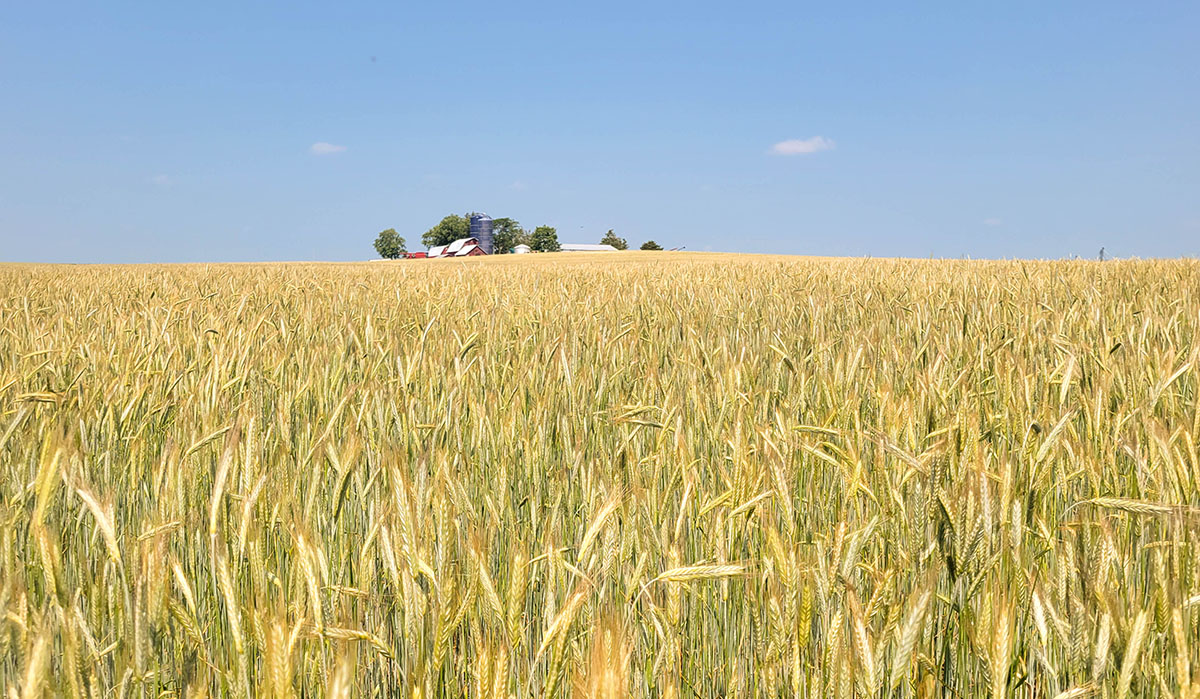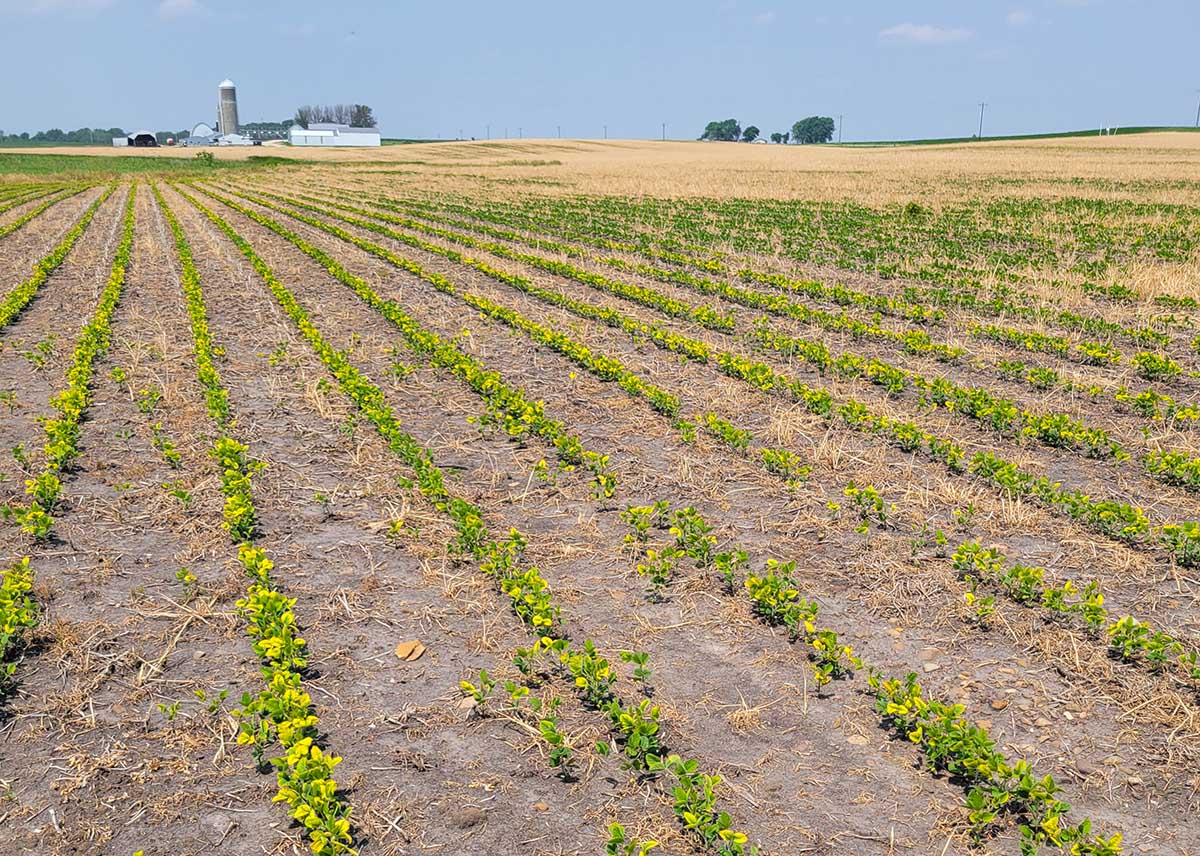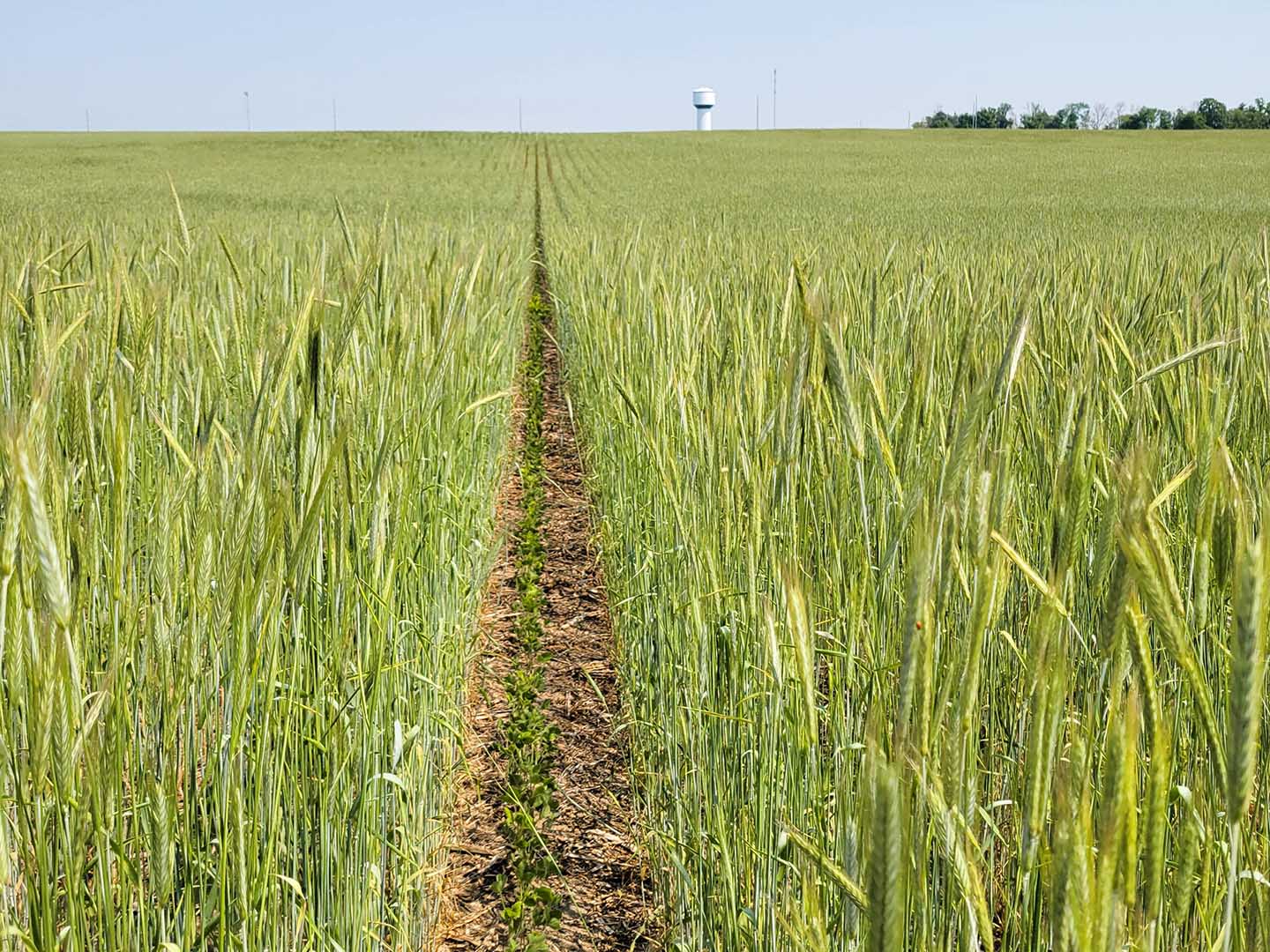
(Photo: Iowa Soybean Association \ Evan Brehm)
ISA experts weigh in on the state of crop conditions
June 29, 2023 | Kriss Nelson
This week’s drought monitor shows that most of the state is in moderate drought with some extreme drought conditions to the west and southeast portions.
“The abnormally dry circumstances are dominating the crop conditions,” says Iowa Soybean Association (ISA) Research Agronomist Scott Nelson.
Dry weather concerns
Alex Schaffer, an ISA research agronomist covering the northeast section of the state, notes soybeans will be less affected by the recent dry weather than corn.
“Corn is determining top-end yield in ear girth at this stage of the growing season,” he says. “Those that received decent rains this weekend should be able to hold on until flowering time. Soybeans will be thirsty in July and August.”
Joe Wuebker, ISA conservation agronomist, reports corn is under stress from drought in west-central Iowa, especially during the hottest part of the day.
Although there is little producers can do about the weather, Wuebker says they could consider a fungicide application closer to tasseling to help with plant efficiency.
ISA Research Agronomist Drew Clemmensen says most crops in his coverage area in southwest Iowa are faring well. However, crops are showing signs of struggle in lighter soils.
However, the signs of stress in corn may not be as concerning as it looks.
“Corn is showing minor leaf rolling, but right now, that is a defense mechanism to protect itself through the day, but at night those leaves are unrolling and taking in the cooler nighttime temperatures to recover from the heat of the day,” says Clemmensen, adding it is a sign that the plant is being able to sustain itself in the short term.
Weather is the driving factor, but Clemmensen says producers can do their part by not adding additional stress to soybeans.
“That means having your post-emergence chemical applied by now,” he says. “Make a conscious effort to wrap those up and remember that the dicamba application date has passed.”
Cover crops
Nelson says he has seen some cases in central and northwestern Iowa where soybeans planted into cover crops appear stunted.
He says this setback is because of the dry conditions, which mainly affect soybean crops if cover crop termination was beyond 12 inches for the cereal rye.
Evan Brehm, ISA conservation agronomist in eastern Iowa, reports that cereal cover crops are in excellent condition.

(Photo: Evan Brehm)
“Rye and oats had a good fall and just enough moisture from the snow. They have a well-established root system from the fall and have found nutrients and moisture,” he says.
Cover crops are doing their job as a natural weed suppressor – especially in the relay crop fields he has inspected.
“Some weeds are coming through in outer rows and near waterways where the weed pressure increases, but field-wide in these relay crop systems, the weed pressure is controlled extremely well,” he says.
A current concern could be the small grains falling over as they approach maturity in the middle of July.
Herbicide carryover and effectiveness
The efficacy of post-emergence herbicides has been a vital concern.
Nelson states that due to hardening weeds, it is more difficult to get active ingredients into them. He suggests farmers talk to their technical advisors about specialty crop oils and surfactants to increase herbicide efficacy.
Herbicide carryover has been causing damage this year and could be an issue in 2024.
“I’ve seen fomesafen (Prefix/Flexstar) carryover from soybeans to affecting corn the following year due to its residual activity,” says Brehm. “There is not much we can do about that. The following year the corn may appear yellow in areas, but generally, is not a yield-limiting factor.”
Pests
Packing a double punch to yields could be insect-feeding this year.
Wuebker says he has seen some bean leaf beetle feedings but is concerned about Japanese Beetles.
“North of Carroll up toward Sac City – everywhere I get out to look, I can easily find them, which is a little unusual for this area,” he says. “As we get into more drought-like weather, we need to watch for bug pressures because of the already stressful conditions, and we could get to the point where an insecticide application is needed.”

Soybean Gall Midge (Photo: Erin Hodgson)
The hot and dry conditions are also an excellent environment for spider mites. Clemmensen says he has seen some pockets of the pest in the field and encourages producers to be out scouting for them.
“Keep in mind, when scouting, and you see pests, there are thresholds for pesticide applications. Just because you find them doesn’t mean you should pull the trigger,” he says. “Continue scouting to see if infestations grow across the field.”
Nelson advises producers to look for a pest becoming more prevalent in Iowa: the Soybean Gall Midge.
“Soybean Gall Midge is a major threat this year,” says Nelson. “Farmers can do nothing about the pest in their fields, as foliar insecticides have proven ineffective.”
Nelson suggests documenting gall midge fields to better plan for next year, with the option to use Thimet insecticide during planting on the end rows.
Nutrient deficiencies
A lack of moisture is causing some nutrient deficiencies. Specifically, in corn, Clemmensen says there have been signs of lack of nitrogen and sulfur in corn.
“Those symptoms are showing up right now because the plant is having a hard time soaking enough nutrients as fast as it is trying to grow right now,” he says.
Brehm has seen potassium deficiency in corn in eastern Iowa and now in soybeans, especially in field edges with compaction.
“Potassium deficiency starts in the lower leaves on the outer leaf margins,” he says. “Dry weather increases the likelihood of potassium deficiency, even in fields with adequate fertilizer applied.”

Potassium deficiency (Photo: Evan Brehm)
Signs of sulfur deficiency in corn are showing in Brehm’s eastern-Iowa region, with white striping on new leaves.
“I’ve seen this simultaneously with potassium deficiency in corn,” he says. “Not so much on soybeans. This also occurs in drought conditions. However, recent rains in areas may bail us out.”
Iron Deficiency Chlorosis is frequent in Wuebker’s area, where rain levels prevent soybeans from taking up iron from the soil.
Producers should talk to an agronomist to assess fields. Would a foliar application be the answer?
“You think your plant lacks something and may want a foliar application. Unfortunately, with the conditions we are in right now, those products may do more cosmetic work by greening up the plant, but there is not a lot of data out there to support increasing yields with those products,” says Clemmensen.
A replicated strip trial could help build that data.
“We are always looking to learn,” he says. “If you are willing to put a product out in strips, we would be more than happy to work with you, collect and analyze the data.”
Relay cropping trials
Depending on the planting system, different conditions of soybeans are being observed in relay cropping trials.
“There are some good-looking soybeans out there with some of my more experienced cooperators who leave a bare strip to plant the soybeans into,” says Schaffer. “The ones that planted into solid seeded rye seem to be struggling.”

(Photo: Evan Brehm)
Schaffer added the soybeans are definitely competing for moisture, and their conditions will be better known once the rye is harvested – most likely by mid-July.
Wuebker says a grower he has been working with has harvested rye in his relay cropping system.
“Even conventional beans are struggling to get much growth with dry conditions,” he says. “I would expect the relayed beans to have a very tough time growing if we don’t get more regular rains soon.”
Back